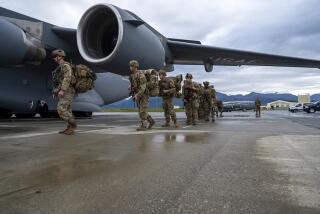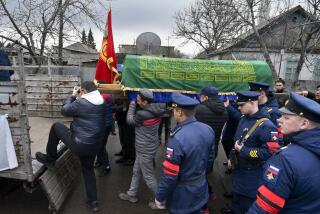U.S. Base Looks a Lot Like Home
BISHKEK, Kyrgyzstan — This is one of the less likely outposts of the war against terrorism: French fighter pilots lift off from an American base in a former Soviet republic near China to attack suspected terrorists in Afghanistan.
The airfield serving the capital of Kyrgyzstan is one of 13 bases that the Pentagon has quietly established in nine Middle Eastern and Central Asian countries neighboring Afghanistan. The Defense Department calls them “expeditionary airfields.”
In some cases, the Pentagon doesn’t even acknowledge the existence of these bases, most of them in Muslim countries where any American presence is highly problematic. But here in Kyrgyzstan, at least, all signs point to a lengthy stay.
When Air Force Brig. Gen. Christopher A. Kelly and a vanguard of 26 officials arrived the day after Christmas, there was little here--no cargo yard, no U.S. or allied aircraft and none of the 275 temporary structures that today make up the coalition’s tent city.
“Basically, this area where we’re standing right now was nothing but a boneyard of broken-down Russian aircraft and Kyrgyz aircraft,” recalled Air Force Master Sgt. Gerritt McCrory.
Compared with the spartan U.S. Army base in Kandahar, Afghanistan, the Air Force has erected a palace here, complete with hot meals and tents with central heating. The site is already home to 650 Americans, 250 French, a handful of Spaniards and at least one South Korean. The total is expected to reach 2,000.
The U.S. agreement with the Kyrgyz government to use the Manas air base lasts only until December. But it continues thereafter unless either nation opts out. And it will be August before all the planes arrive.
“After what we’ve done here, we’re not going to want to tear it down after a year and bulldoze it,” said Col. Billy Montgomery, Kelly’s chief of staff.
The site is officially described as a refueling base for planes flying in and out of Afghanistan. But the coalition plans to crowd the runway with C-5, C-17 and C-141 cargo planes, French and Turkish refueling tankers, commercial 747s and Russian-built Antonov 225s. The facility is already moving cargo to bases in the Afghan cities of Kandahar, Bagram and Mazar-i-Sharif.
U.S. and coalition partners also have begun to operate C-130 cargo planes, KC-135 and other refueling tankers, and Marine F/A-18 Hornet and French Mirage fighters, like those used in the attack on suspected Al Qaeda and Taliban forces in the fierce battle last month in the Shahi Kot valley.
Although the United States is unlikely to station forces permanently at Manas, “what usually happens is, we leave behind a great deal of equipment, a great deal of relationships and experience that essentially put that base on the list of places from which we can now operate in the future,” said Michele Flournoy, a former Pentagon official now with the Center for Strategic and International Studies, a Washington think tank.
“I think we’ll stay here as long as the relationship is good,” Montgomery said.
The relationship is good for good reason: It’s a lucrative arrangement for the Kyrgyz. The U.S. military presence is expected to pump more than $40 million into the weak local economy this year. That doesn’t include visits by troops to Bishkek, where $30 buys dinner and caviar for four at one of the capital’s priciest bistros.
Manas holds two attractions for the anti-terrorism coalition. It is relatively close to the war and has an unusually long--13,800-foot--runway built to accommodate Soviet bombers. The base lies less than 1,000 miles from Kandahar, a three-hour flight for heavy cargo aircraft.
Yet it also has serious limitations. Commercial aircraft use the site, and customs agents in Soviet-style olive uniforms pore at length over each visitor’s identification. There is room for only four C-17 or C-5 cargo planes to park along the taxiway, so crews are discouraged from staying overnight. Turkish and Italian commanders would like to operate here, but there’s not enough room.
As with some other allies in the anti-terrorism coalition, Kyrgyzstan has additional issues. Human rights are sometimes regarded as optional; American diplomats are pleading with their Kyrgyz hosts to free jailed opposition members of parliament.
However, on invitation of the government, U.S. Army Special Forces soldiers began training local soldiers here well before Sept. 11. That cooperation has been enhanced with new training of border guards, carried out through the State Department.
The Pentagon has learned the hard way the dangers of being unwanted, through such incidents as the 1996 bombing of the Khobar Towers military housing complex in Saudi Arabia that killed 19 U.S. servicemen. And even though U.S. troops are here at the invitation of the Kyrgyz government, this largely Muslim region holds risks for Americans.
Among them is the Islamic Movement of Uzbekistan, whose goal is to carve out a Muslim republic spanning several nations in the region. Members of the group are thought to have fought alongside Al Qaeda in Afghanistan and were among the targets of French fighter jets based here.
To protect the airfield against threats, commandos from Moody Air Force Base in Valdosta, Ga., patrol rural hamlets within about a four-mile perimeter.
As more than a dozen U.S. troops rolled through an agricultural village called Vostuchny, they encountered watchful scrutiny, handshakes and children who reached out to touch the Americans’ rifles. Most of the Kyrgyz seemed friendly.
“They should have come long ago,” Alec Kurbanov, who served in the Soviet army from 1972 to 1974 and looks two decades older than his 49 years, said in Russian through a translator. “We don’t hold anything against them, as long as they have peace in mind.”
Others were more skeptical. A man who identified himself only as Sergei expressed concern about the Americans’ weapons.
“You carry guns, as you are surrounded by all these kids,” he said in Russian. “I believe you could have talked to the villagers without your weapons.”
Then he raised the same complaint that Osama bin Laden has cited as justification for attacking Americans: “What is your reason for being in Saudi Arabia?”
Meanwhile, camp commander Kelly meets several times a week with his Kyrgyz liaison, Gen. Boris Polluto, who served as a Soviet soldier during the Cold War. Back then he was poised to do battle with the man who now calls him a good friend.
Few of the American troops ever expected to be here.
Said Airman 1st Class Ben Frankenberry, a 19-year-old Seattle native who was just deployed here from the Pacific island of Guam, “My recruiter left this part off the video.”
More to Read
Sign up for Essential California
The most important California stories and recommendations in your inbox every morning.
You may occasionally receive promotional content from the Los Angeles Times.










